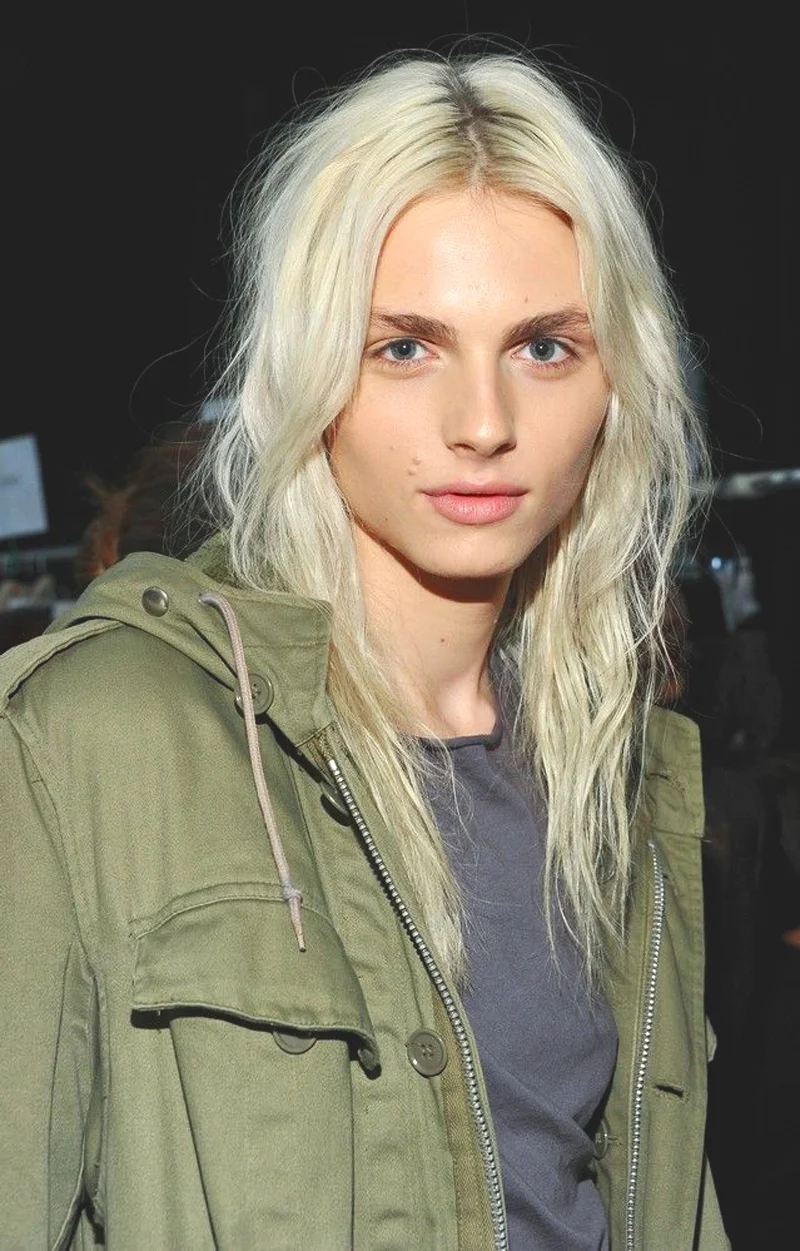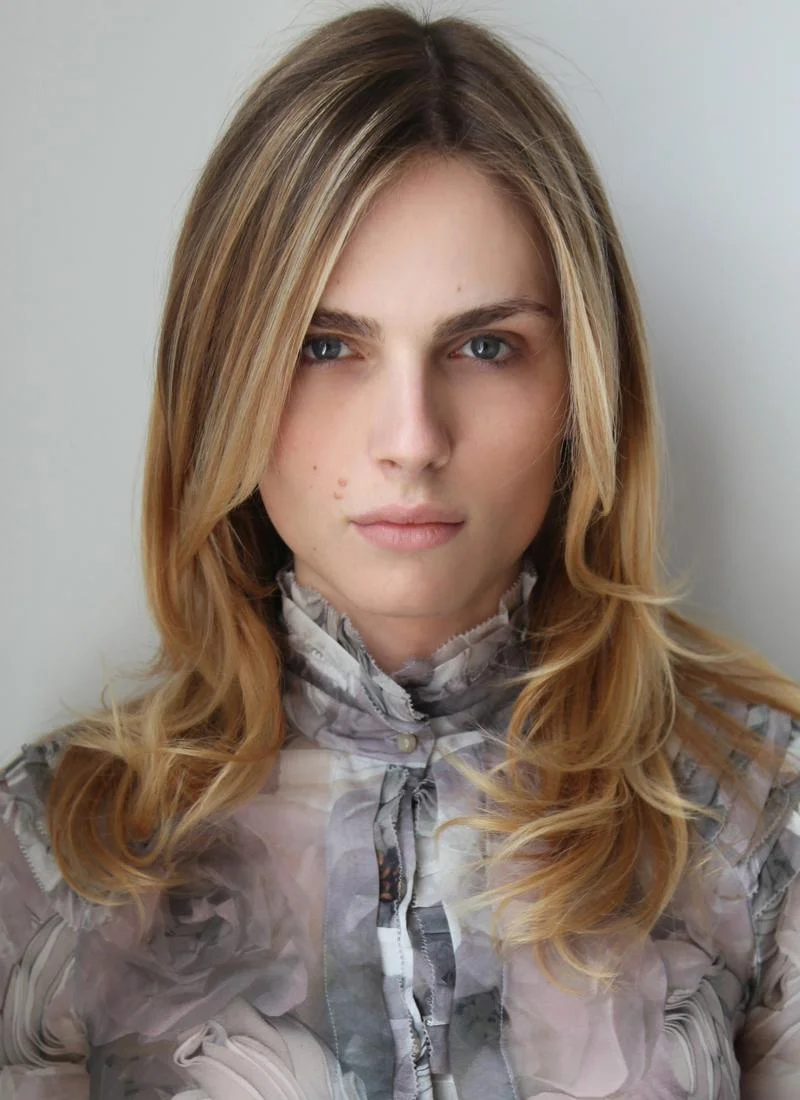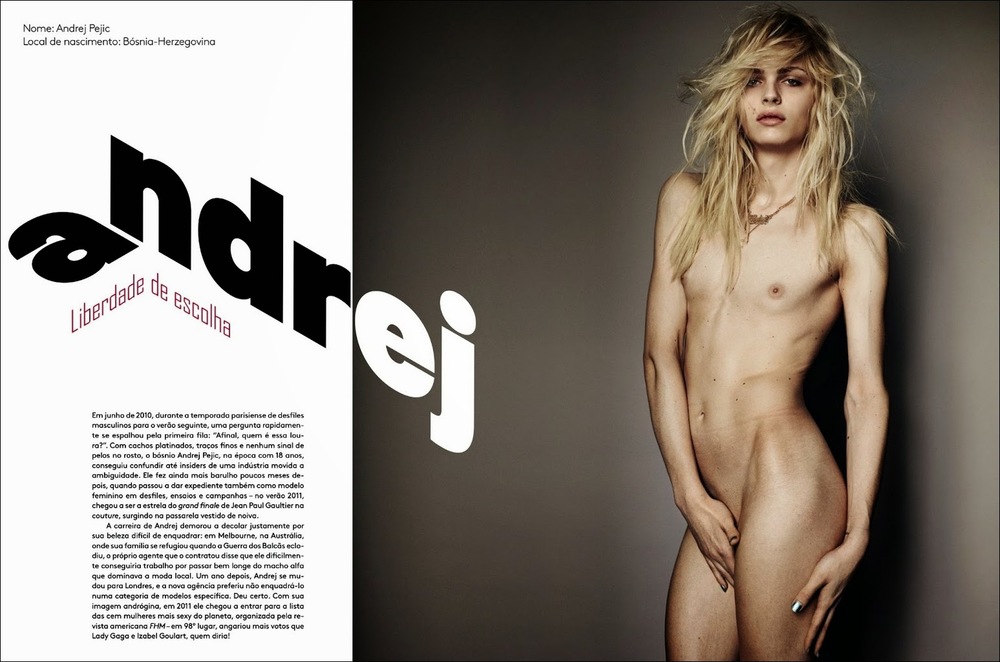Andreja scores Makeup Forever
Thought this interview with Andreja was so inspiring, I wanted to repost it. Thank you STYLE.COM!!
Andreja Pejic Talks Contouring, Caitlyn Jenner, and Why a Bikini Can Be Freeing
Amber Kallor
People
June 5, 2015 — 02:00PM
“It’s important to me that people can associate being different with being beautiful.”
Just 10 months ago, transgender model Andreja Pejic told Style.com it would be “cray cray” if she landed a beauty campaign. Come July 16, that pipe dream will become a reality—and an eyeshadow palette. Make Up For Ever (MUFE) signed the model without hesitation long before Caitlyn Jenner covered Vanity Fair. “Dany [Sanz, founder of the cosmetic company], when she talks about the brand, talks about diversity and being able to be yourself—whatever yourself means,” explained U.S. general manager Laure de Metz, on why the brand selected Pejic to front its forthcoming ad (alongside actress Jamie Chung) that bears the slogan “Be bold. Be unexpected. Be you.” “Transformation is something that’s been there forever, it’s nothing out of the ordinary for [Sanz]…the shock value, if you will, is not there.” And it seems that shock value in landing a major makeup contract isn’t there for Pejic, either: “The world is a diverse place—it’s as diverse as [MUFE’s] 40 shades of HD foundation—and there is no reason that the beauty industry should not reflect that.” Here, the model explains the importance of blending, why a bikini can be freeing, and how beauty can bridge people together.
On the runway at Giles Fall '15 show
Photo: Yannis Vlamos / Indigitalimages.com
You told Style.com that it would be “cray cray” to nab a coveted beauty contract, yet here you are in billboard-size form for Make Up For Ever. How does it feel?
I’m definitely still taking it all in, but it feels incredible to do it in such an organic way with a brand like Make Up For Ever. I feel like we align so well with what our message is. Personally, I didn’t think it would come now, so I just feel very blessed to transition and become a woman and come out publicly and be accepted. I had to go through some trials and tribulations, and it definitely wasn’t all easy. But to come out on top of it with such a great project, such a great cosmetics contract, it was incredible. And I think it’s nice to prove them all wrong. They used to tell me that my career would probably end after I transitioned, and that trans women don’t get respected in fashion as models, so it’s nice on a lot of levels.
You talked about that message that you and MUFE share. Can you tell me a little more about what that is?
Well, the campaign is “Be bold. Be unexpected. Be you.” And it kind of sums up a lot of the ideas and packages them so nicely. I feel like that’s kind of what I’ve been trying to get across, even before the transition, but especially after. It’s important to me that people can associate being different with being beautiful. And beauty should be about diversity. We live in a diverse world, so why should there just be one standard, and why should it be explored in just one way? It’s about bridging differences between people and uniting people and kind of showing that you can learn from this if you’re in the LGBT community—and even if you’re not—because 90 percent of the population has felt different or insecure at some point in their life.
"They used to tell me that my career would probably end after I transitioned, and that trans women don’t get respected in fashion as models, so it’s nice on a lot of levels."
—Andreja Pejic TWEET THIS QUOTE TWEET THIS QUOTE
And obviously a little lipstick never hurt anybody.
Who doesn’t feel prettier with makeup on? There is no [one]. Find that person and I’ll give them 50 bucks!
You said in a previous interview with Style.com that breaking into beauty was even more of a challenge than breaking into fashion. Why do you think that is?
Well, first of all, I feel like beauty is really “mass.” The really creative part of fashion, the really experimental part of fashion, is actually a very small part of the fashion industry. And [fashion] really runs on the sales of perfumes and cosmetics—it makes up the financial structure. I’ve definitely been accepted by photographers and done a lot of editorials and had a lot of success in that arena, but for me, something like a cosmetics contract breaks more boundaries because it’s showing that the consumer can relate to someone like [me] and a woman will buy the products that you advertise. A lot of people in the beauty industry didn’t believe that that was possible. I’ve been told, “Oh, we don’t know how women will react. We don’t know if women are going to be jealousif they just won’t align with this lifestyle, and we don’t want to alienate [people].” I always felt like with market research and Oh, it’s never been done before, that we have no frame of reference. But I also believe that it has to do with the prejudices of those people [making the calls], those internal prejudices—and we’ve all got them. I feel happy to be showing that this is possible.
Pejic's namesake Make Up For Ever Artist Palette, available July 19
Obviously, this project has been in the works long before Caitlyn Jenner was on the cover of Vanity Fair.
Oh, yeah. This was confirmed around the same time American Vogue was confirmed. So really, at the beginning of the year, I got a call from my agent, and they were like, “We’re working on a cosmetics contract, we’re working on this really big thing.” And I was like, “Whoa.”
With everything that’s been reported surrounding Caitlyn Jenner, are there any misconceptions or things that you think the public doesn’t entirely understand about the transgender experience?
People will still reduce transition down to trivial things. They’ll sometimes say that you did it for attention or for your career. To me, it’s almost laughable to imagine someone changing their body, their social role, everything about them [for that]. Could you imagine transitioning into a man for money? I think that people, when they think that, they don’t try to relate. They cut off the empathy. If they really thought about it and imagined what it would be like for them to transition and to feel uncomfortable in their body, then they would not relate it to those things.
"It’s important to me that people can associate being different with being beautiful."
—Andreja Pejic TWEET THIS QUOTE TWEET THIS QUOTE
You obviously had a very strong sense of self to live your life the way that you wanted at a fairly young age in comparison to Caitlyn Jenner, who waited much longer.
I do think it’s important to remember that Caitlyn’s story is one story. I would say it’s more representative of the older generation, and it’s the kind of story that’s been around for the past few decades. I feel like my story is a little more representative of the new generation and the Internet generation. The Internet really helped me to discover who I was at the age of 13, and discover what it meant to be trans, discover doctors, discover hormones—everything. It’s very important to see a variety of stories, and just to see the individuality in everyone’s [experience], and to not group everyone just by the fact that they’re trans. I feel like that’s how you perceive other human beings, you know. You perceive them as having lots of diversity. I think the challenges of transitioning later [in life] are much different from when you’re younger, too.
When you spoke to Style.com last, you noted that until you underwent sex reassignment surgery, you didn’t like what you saw in the mirror—especially when you were naked. How do you feel now?
I’m very happy with the situation! [laughs] It’s about freedom. It’s so freeing, just going to the beach. I can’t wait to put on a bikini and go to the beach and not have to worry and just enjoy it. I love the beach! So it’s just very freeing.
An image from Pejic's forthcoming campaign for Make Up For Ever
I suppose that cosmetics, in a way, can have the same freeing effects as a bikini. When did you first start dabbling in makeup?
Well, my first experiences with makeup were when I was 3 or 4. I grew up idolizing my mother and she liked to dress up. She was a feminine woman. I would be obsessed with her lipsticks and blushes, and it was just such a forbidden thing, but it was what defined womanity and growing up. That was kind of that early fascination, and there was a period where I felt like it definitely wasn’t OK and I had to steer clear of anything feminine, especially makeup, since I was growing up in this sort of normative environment and I was trying to be a boy and makeup just wasn’t the normal thing for a boy to do. And then at the age of 14, I discovered who I was and decided that I needed to express my femininity, and if not transition all the way at the time, then just to enjoy life. It started out as a little emo phase, lots of eyeliner and light foundation, very dramatic, and then it evolved from that. I had a lot of girlfriends in high school, and so there was definitely a period of lots of bronzer. In Australia, we’re all obsessed with fake tans. And when I started modeling, I discovered so many great tricks and great brands like MUFE that really offered these great products that you could really have fun with. That’s what I like to do, play around with makeup and just have fun and learn new things.
Can you share some of your favorite tricks you’ve learned as a model?
Definitely. Just working with the MUFE family, I’ve learned how to blend better. I was taken to the pro studio and given a whole tutorial. Lijha [Stewart, director of education and artistry] actually taught me how to blend on a whole new level. When I would apply my eye makeup, you know, you use one brush for the lighter color inside [of the lid] and then a darker color on the outside. But it would never look as great as backstage at a shoot, and I couldn’t figure out why. She taught me that once you apply both colors, you really have to go over with the brush and blend everything to make it all one.
Photo: BFA NYC
Do you use a circular motion, or what is your technique?
You can do a circular motion using a very light brush and it blurs lines between the dark and the light, or between different colors. It’s very important—that’s how you make it look quite professional. And you need to do it even when you’re contouring—for every process. Blending is extremely important. The MUFE brushes are amazing for that.
I suppose you went from zero to 60 with Make Up For Ever, as they have 1,600 products in the range.
Yes, exactly. I walked in and I was like, “Wow!” It’s makeup heaven. You walk in and there are so many options, and I just need to take everything!
Sultry, smoky eyes for the new ad
You said that as a young boy you would have been happy scrubbing toilets as long as you were doing it as a woman.
That is how I saw the world as a child, definitely. And on some level, that was true…That’s what transition is really about: Would you rather be an unsuccessful, poor woman than the most successful, beautiful guy? And now I get to exceed those childhood expectations and I get to be a cover girl for Make Up For Ever. It’s incredible. I didn’t come from privilege, I came from a poor, single, working-class mother. It’s nice to have the glitz and the glam now.
What is your must-have makeup product?
Obviously, the new Ultra HD foundation [available in July]. I put it on over the weekend because I went to the [Veuve Clicquot] Polo Classic and it’s during the day, so there’s no cutting corners. Everyone sees everything. So the makeup has to be on point. And I used the Ultra HD foundation for the first time, and I was amazed how well it went on because it wasn’t too much coverage. You never want to look cakey, and I feel like with foundation, it’s all about balance. And the HD Stick [out in September] is amazing for contouring. I have converted and seen the light of contouring with foundation sticks.
Photo: BFA NYC
Do you have any good tips for contouring?
The HD stick is a solid form of the liquid foundation, and you would apply the darker shade like you would the contour, and the lighter shade on top. Then you blend both in with a brush. For me, it creates a more natural look than doing powder because it looks like skin.
I know that you received a little pushback in regards to your surgery from some people in the industry who said that you should remain an androgynous model because otherwise you’d just be another pretty face. What would you say to those people now?
You know, I feel like I’m able to do what I used to on an even bigger level and spread an even bigger message than I’ve ever done before. And you know, it feels good. I have to say it feels good to have proven those people wrong, to dispel the stereotypes, and to be able to associate who I am with being successful. It feels incredible.
"It’s very important to see a variety of stories, and just to see the individuality in everyone’s [experience], and to not group everyone just by the fact that they’re trans."
—Andreja Pejic TWEET THIS QUOTE TWEET THIS QUOTE
Your campaign sends a strong message to an even younger generation of people who might be struggling with the same issues you had as a child. I suppose this example of success wasn’t available to you as a boy.
No, it wasn’t. There were no examples. I look back and there were people like April Ashley, Teri Toye, Tula—and the Stonewall riots—who were at the forefront of everything before this movement ever existed. But at the time [of my childhood], there really weren’t that many examples. I just think that the way the younger generation is viewing sexuality and gender is changing rapidly. There’s more fluidity, a better understanding, and there’s more sensitivity. I think [my campaign] does speak to those young kids that might be growing up now and going to their parents and expressing gender identity variations and different sexualities. It’s pretty cool.
In terms of the fashion and beauty industry, how do you think your campaign will spur change as we move forward?
I think it will show, from a purely business point of view, that I have what it takes to model as a woman and to be seen as a woman. For me, being a trans woman feels like being any other type of woman. It’s like being an Asian woman, or being an African-American woman—it’s just another type of woman, and it doesn’t make me any less of a woman, and you shouldn’t put me in a different category. Many people believe, or believed for a long time, that a trans woman cannot sell products to other women, and it’s almost like saying that Naomi Campbell cannot sell products to white women or that an Asian model cannot sell products to white women, which is ridiculous because they do.
And you are.
And I am. There you go.
[youtube=://www.youtube.com/watch?v=NtLTEAywMvI&w=854&h=480]












